Planning to build your own outhouse? Our 15 free diy outhouse plans are a practical solution to your outdoor needs. This comprehensive guide, complete with a list of tools and materials, will equip you with everything you need to start a DIY outhouse project.
Going through our collection, you will find everything from simple outhouse plans to more detailed outhouse blueprints. Each plan is designed to guide you through every step of the process, ensuring that you can construct a reliable and efficient outhouse.
Stay tuned for insights on planning, preparing, and the actual build – making the whole experience manageable and enjoyable. Get ready to transform these DIY outhouse plans into your next successful outdoor project!
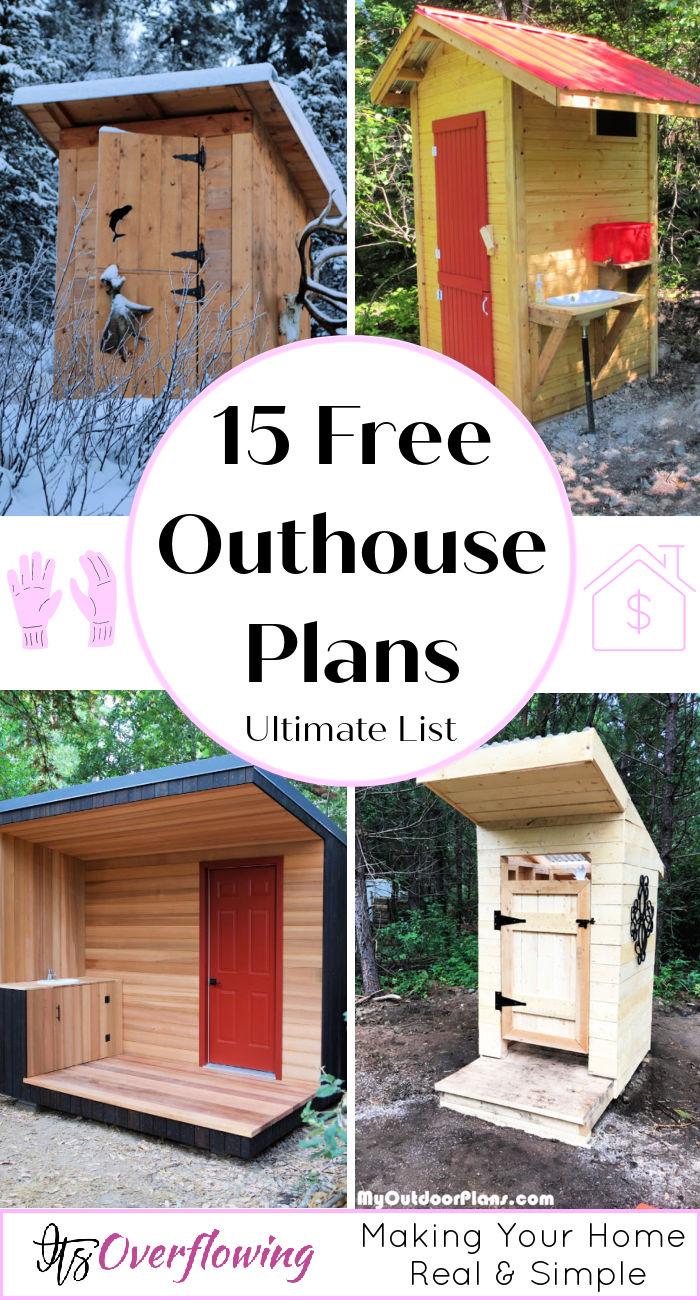
Why Build an Outhouse?
Building an outhouse offers several advantages that make it a worthwhile project. Here’s why you might consider adding one to your property:
- Cost-Effective: Traditional plumbing can be expensive, especially in remote or off-grid locations. Outhouses require minimal investment, saving you money on both installation and maintenance.
- Eco-Friendly: Outhouses minimize water usage, conserving a vital resource. They can also be paired with composting techniques to turn waste into useful fertilizer for gardens.
- Convenience: For properties without immediate access to indoor plumbing, such as cabins in the woods, an outhouse provides a practical and necessary facility.
- Simple Construction: Many outhouse designs are straightforward, making them a manageable project for DIY enthusiasts with basic carpentry skills.
- Customizable: Outhouses can be tailored to fit the aesthetics of your property or the specific needs of your family or guests.
- Emergency Readiness: In times of plumbing failures or during water shortages, having an outhouse ensures continuous access to sanitation.
- Regulation Compliance: In some areas, laws and regulations make it difficult to install conventional septic systems. Outhouses often offer a compliant alternative.
By considering these factors, you can make an informed decision about whether building an outhouse is the right choice for your situation. With careful planning and execution, you can create a functional, environmentally responsible, and cost-effective solution to meet your outdoor sanitation needs.
How to Build an Outhouse: A Step-by-Step Guide
Constructing an outhouse might seem like a throwback to a bygone era, but for many, it remains a staple of self-sufficiency and a necessary addition to remote or off-grid locations. This step-by-step DIY outhouse guide will walk you through the process of safely and effectively building your very own outhouse.
Here’s a detailed breakdown of the process, from planning to maintenance, to help ensure your outhouse serves its purpose for many years to come.
Planning and Preparation
Before you dig into this project, careful planning is necessary. Choose a location that is a safe distance from your home, water supplies, and areas where people gather. Check with local authorities for regulations and necessary permits, and make sure you have all the essential tools and materials ready. Treat this as you would any other construction project.
Here’s what you’ll need:
- Pressure-treated lumber for the base and framing
- Plywood or tongue-and-groove boards for the siding
- Metal roofing or shingles
- Concrete mix for the foundation
- Wood screws and nails
- Hinges and a latch for the door
- Ventilation pipe and cap
- Toilet seat and cover designed for outhouse use
- Waterproofing sealant
- Exterior paint or stain
- Gravel for drainage
- Insulation materials
- Sanitation and cleaning supplies
Designing the Outhouse
Size does matter here. Determine the number of people the outhouse will serve, then decide on the dimensions. Keep in mind the required layout for privacy and ventilation purposes. You’ll want to ensure a comfortable and safe distance between the toilet seat and waste collection, as well as any walls.
Building the Foundation
The foundation of your outhouse is critical for both stability and sanitation. Begin by digging a hole approximately 3 to 4 feet deep. Next, you’ll pour concrete to form a sturdy base, ideally with concrete blocks as support for the structure. This will prevent the outhouse from shifting or leaning, particularly when the ground freezes or thaws.
Constructing the Walls and Roof
Start by framing the walls using your pressure-treated lumber. Once the frame is complete, install plywood or tongue-and-groove boards for the siding. For the roof, build a simple, angled frame using additional lumber, and then affix the chosen roofing material. Galvanized metal roofing is a popular choice for its durability and low maintenance.
Installing the Door and Windows
The door should be weatherproof and provide privacy. Install simple, slatted windows high on the walls for light and ventilation. Make sure any openings are covered with screens to keep out insects and unwanted pests.
Adding the Interior Features
For the interior, construct a toilet seat and box to safely contain and manage waste. Then, include a ventilation system. This is usually a pipe that extends from the outhouse through the roof, which can be screened or capped to prevent animals from entering.
Finishing Touches
Waterproof and insulate to protect the outhouse from the elements and improve longevity. Finally, paint or stain the exterior to match or complement your surroundings, and consider adding a path or steps, especially if it’s a frequently used structure.
Maintenance and Upkeep
Regular maintenance is important for the longevity and functionality of your outhouse. Perform routine cleaning and sanitizing, checking for any wear or potential repairs. This could involve adding additional sealant to the roof, inspecting the structure for any signs of damage, and ensuring the ventilation system is operational.
Building an outhouse is a labor of love and a testament to your self-sufficiency skills. Once your outhouse is complete, take a moment to appreciate the service it will provide and the satisfaction that comes with a DIY project executed thoughtfully and thoroughly.
Tips and Tricks for Building an Outhouse
When start building an outhouse using our DIY outhouse plans, it’s essential to arm yourself with practical tips and tricks to make the process smoother and more efficient. Here’s a helpful compilation:
- Location Matters: Choose a spot at least 150 feet away from any water source to prevent contamination. Ensure the area is accessible year-round.
- Dig Deep: The pit for your outhouse should be at least 3 to 5 feet deep, depending on the number of users and frequency of use.
- Ventilation is Key: Incorporate a vent pipe from the pit to above the roof line for proper airflow, minimizing odors and deterring flies.
- Consider the Direction: Face the outhouse door away from your home or main camping area to keep any unpleasant odors at a distance.
- Use Sustainable Materials: Whenever possible, opt for rot-resistant wood or recycled materials to enhance durability and sustainability.
- Privacy Matters: Ensure the door latch is secure and consider adding a lock for extra privacy and safety.
- Mind the Details: For comfort, include a seat with a lid and perhaps a small window for natural light.
- Regular Maintenance: Even after successful construction, regular check-ups and cleanings are crucial to maintain hygiene and ensure longevity.
Following these simple yet effective pointers will not only help in building a functional outhouse but also in ensuring it stands the test of time while meeting your outdoor needs efficiently.
FAQs on Building an Outhouse
Whether you’re an off-grid enthusiast, a homesteader, or you simply enjoy DIY projects that instill a sense of self-sufficiency, building your very own outhouse can be a fulfilling effort. Discover frequently asked questions (FAQs) about building an outhouse.
Why Build an Outhouse?
An outhouse is a simple and effective waste management solution that can be especially useful in remote areas without access to plumbing. It’s an eco-friendly alternative, as it doesn’t rely on water usage, and can provide an additional layer of privacy compared to a full indoor bathroom.
Where Should I Build an Outhouse?
Select a location that is well-drained and not prone to flooding. It should be on high ground to prevent the accumulation of water, and consider the proximity to walking paths — you’ll want a spot that’s both convenient and discreet.
What Are the Legal Requirements for Building an Outhouse?
The legality of building an outhouse can vary depending on your local regulations. Before you start, check with your municipal office to ensure compliance with any zoning or health codes that may apply to the construction or use of an outhouse.
How Deep Should the Hole Be?
The depth of the pit for a traditional outhouse should be at least four feet deep to promote proper decomposition and prevent any groundwater contamination. A typical pit depth ranges from 6 to 8 feet.
How Do I Construct the Outhouse Structure?
The outhouse structure should provide privacy and be well-ventilated. Usually, a simple shed-style with a bench inside is sufficient. The superstructure can be made of wood, metal, or even bricks, depending on your preferences and the availability of materials.
What Materials Should I Use?
Pressure-treated lumber is an excellent choice for the frame of the outhouse, as it’s resistant to the elements. Cedar is often used for the outside of the outhouse, thanks to its natural resistance to decay. Corrugated metal sheets make for a durable and weatherproof roof.
How Do I Ensure Proper Ventilation?
Ventilation is crucial to keep the outhouse from smelling and to help aerate the waste for decomposition. This can be accomplished with a vent pipe leading from the pit to the exterior of the structure, allowing for a passive airflow.
How Do I Prevent Odors?
Aside from proper ventilation, you can add a layer of limestone or ash to the pit, which acts as a deodorizer. Regular maintenance and prompt attention to any issues can also go a long way in keeping your outhouse odor-free.
What Are the Maintenance Requirements?
Outhouses need regular attention to remain clean and functional. This includes emptying the pit when it reaches capacity, as well as ongoing checks for structural integrity, insect infestations, and the condition of the seat.
Free Outhouse Plans
Looking to build your own outhouse? Find free outhouse plans perfect for homesteading and off-grid living.
Now that you’ve been equipped with the details grab those plans, gather your materials, and head to the great outdoors to get started on your outhouse masterpiece!
1. How to Make an Outhouse for Cabin
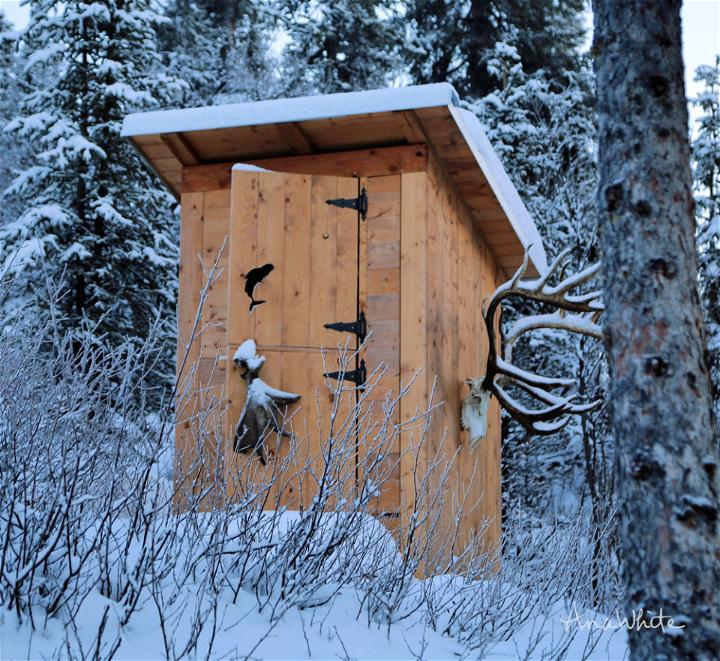
Explore Ana White‘s insightful guide on building an outhouse for your cabin, a practical solution for off-grid living in challenging climates like Alaska. The post provides a firsthand account of why traditional options like composting toilets and sewer systems may not be suitable, and why an outhouse can be an effective alternative. Ana shares her personal experience with outhouse construction, offering tips on materials, design features, and maintenance.
With detailed plans and a candid discussion of the realities of remote living, this resource is invaluable for anyone considering an outhouse for their rustic retreat. Engage with Ana’s plans to create a functional, roomy, and non-smelly outhouse, perfect for embracing the great outdoors without sacrificing comfort.
2. DIY Outhouse With Scrap Wood
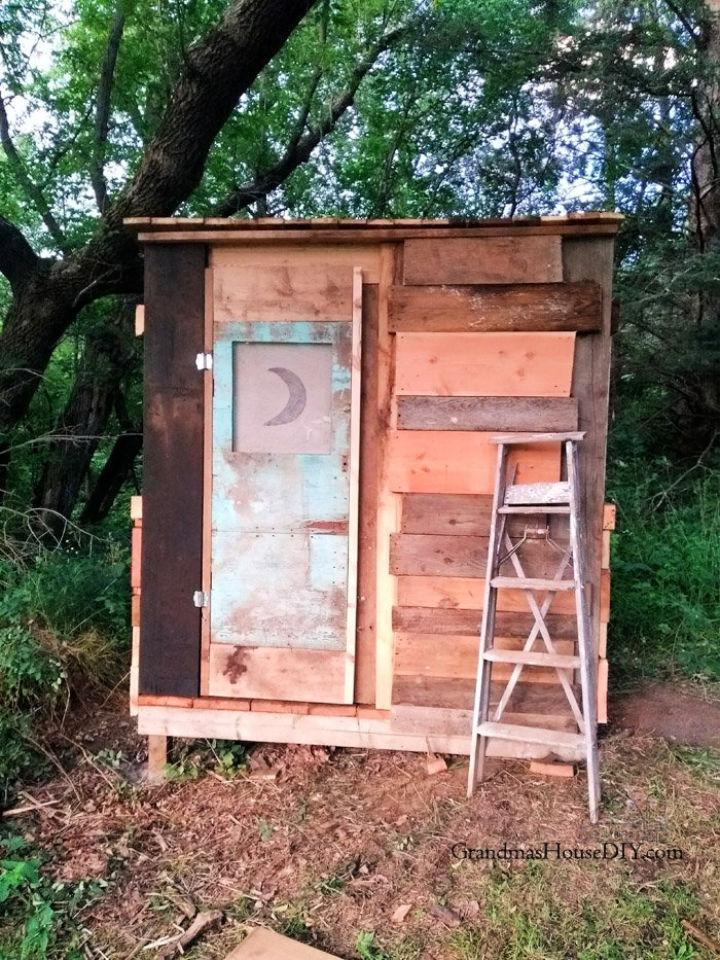
Discover how Tarahlynn from Grandmas House DIY tackled the challenge of constructing a functional and charming outhouse using only scrap wood and a few new materials. Her instructive narrative guides you through each step, from selecting the perfect spot to digging the hole and crafting a sturdy structure.
Her hands-on experience and clever tips provide valuable insights for DIY enthusiasts looking to build their own outhouse with limited resources. Emphasizing sustainability and creativity, Tarahlynn’s project is a testament to the joys and rewards of self-reliance in home improvement.
3. Modern DIY Wooden Outhouse
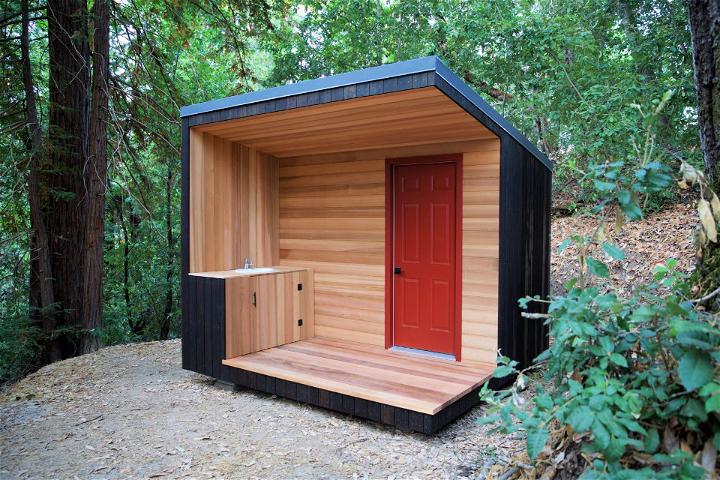
Building your own modern outhouse adds a unique and functional touch to your property. Jeff Waldman’s guide on Dwell provides step-by-step instructions on constructing “The Cube,” an eco-friendly pit toilet nestled in California’s Santa Cruz Mountains.
From selecting the right location to incorporating modern design elements, this comprehensive tutorial covers all aspects of creating a stylish and practical outhouse. With tips on digging the pit, designing the structure, and adding finishing touches, you’ll have all the information needed to construct a charming outdoor facility that’s both a conversation starter and a testament to your DIY skills.
4. How to Build an Outhouse
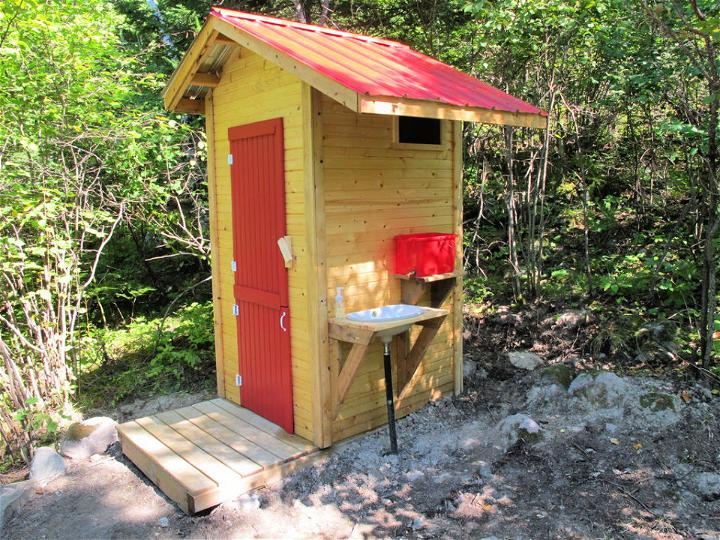
Planning to build an outhouse can be a practical and eco-friendly project. Before starting, it’s essential to check local regulations regarding waste systems. Instructables provides a comprehensive guide that walks you through constructing an outhouse, complete with a washing station. The instructions are clear, making the process manageable for those who wish to tackle this hands-on endeavor.
With attention to detail and a focus on sanitation, you can create a functional outdoor bathroom that serves its purpose well. Remember to prioritize environmental considerations and user comfort to ensure your outhouse is a welcome addition to any outdoor space.
5. Making an Outhouse Under $150
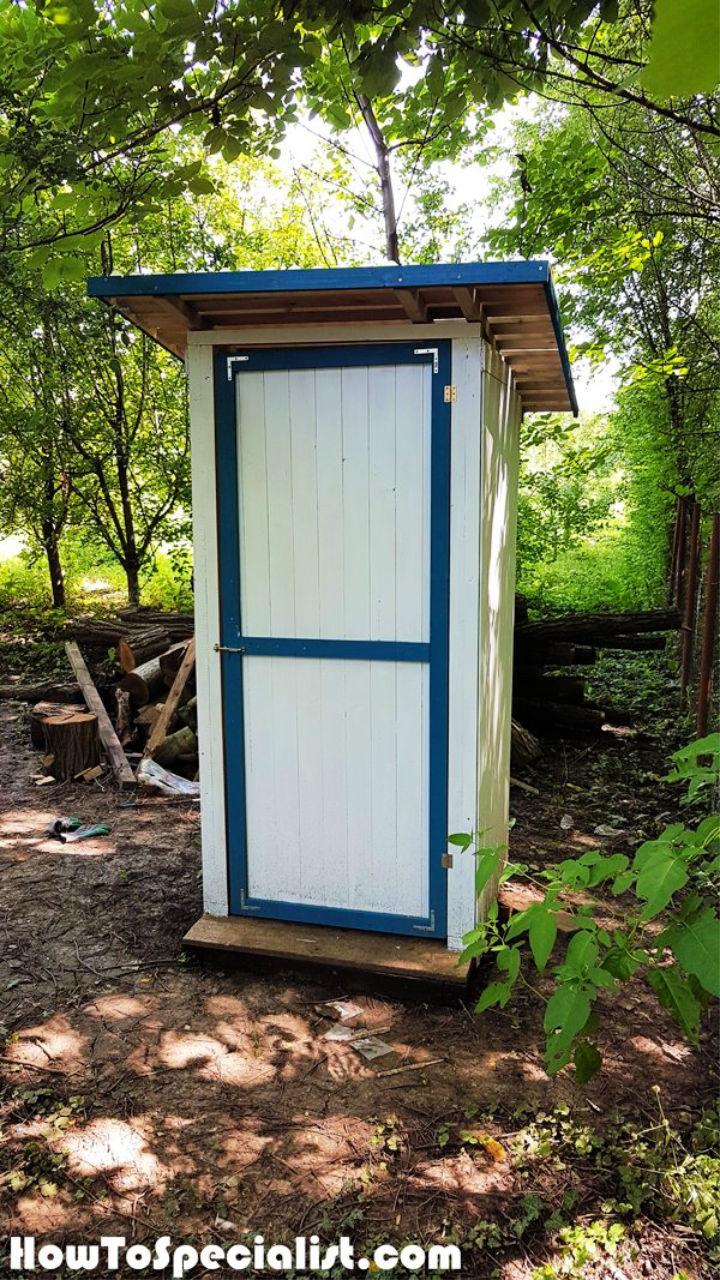
Looking to construct a simple outhouse for your countryside property? HowToSpecialist provides a comprehensive, step-by-step guide to help you create a practical and cost-effective outdoor toilet. With clear instructions, this DIY project is manageable for anyone keen on woodworking, and it’s designed to be completed over a weekend. The guide emphasizes the use of weather-resistant lumber and encourages precise measurements for a perfect build.
You’ll find helpful tips on ensuring a level base, constructing a sturdy frame, and fitting all elements securely. For added convenience, free plans are available for download, allowing you to tailor the outhouse to your specific needs. With a total cost under $150 and requiring only basic tools, this project is both accessible and budget-friendly. Get ready to enhance your outdoor space with a functional outhouse that can later transform into a garden shed.
6. Free Wooden Outhouse Plan
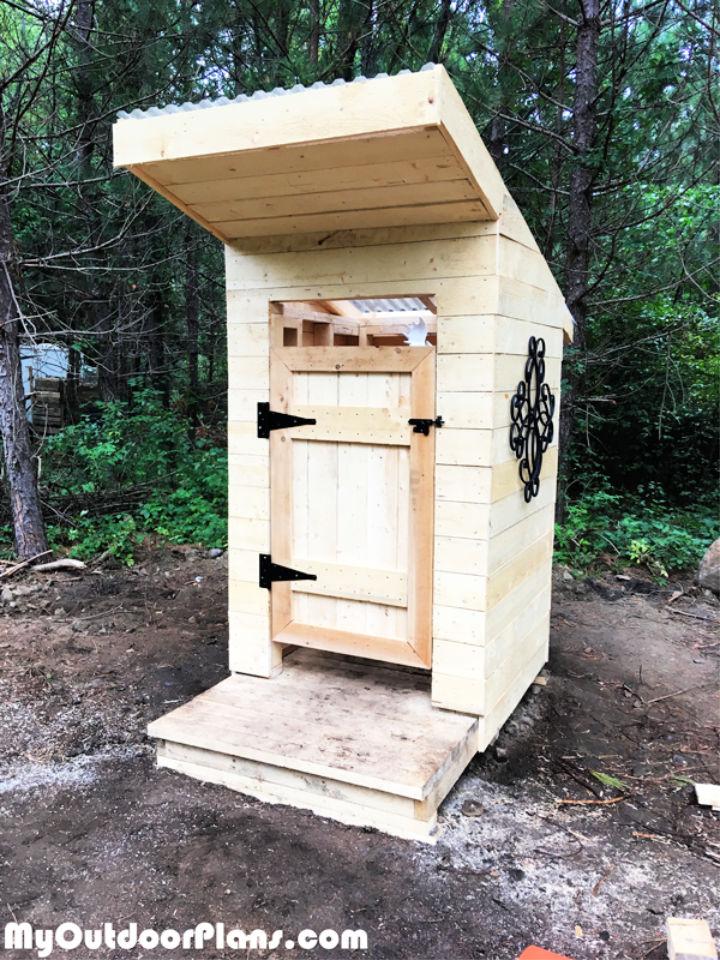
Ready to construct a durable outhouse with ease? MyOutdoorPlans provides detailed, step-by-step woodworking plans tailored for DIY enthusiasts aiming to create a lean-to outhouse. With careful lumber selection and basic tools, this guide ensures a smooth building process. The instructions cover everything from crafting a sturdy floor frame to attaching the decking and walls, all while ensuring symmetry and structural integrity.
For a polished finish, fill any holes, sand the surfaces, and apply your chosen paint or stain. With these plans, your outdoor project can be completed in just a day, leaving you with a functional and well-crafted outhouse. Dive into the guide, and let MyOutdoorPlans lead the way to your successful build.
7. How to Make a Plywood Outhouse
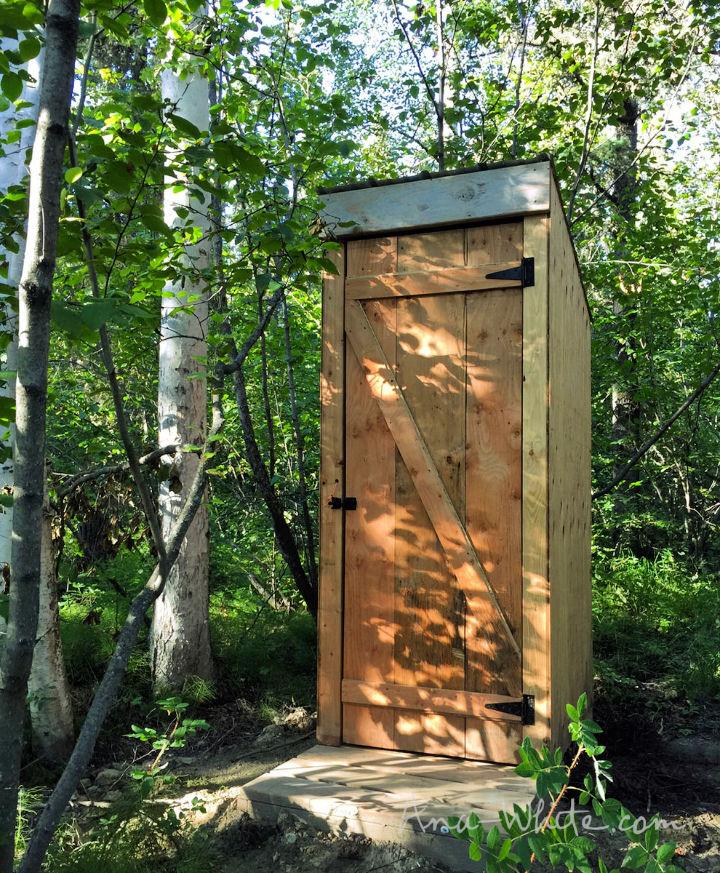
Building a simple outhouse can be a practical solution for off-grid living or as an eco-friendly option for tiny homes. Ana White offers a step-by-step guide on creating a sturdy and functional outhouse that is optimized for minimal waste and easy transport. With plans tailored for standard plywood and roofing sheets, you can construct a durable outdoor bathroom that withstands harsh climates like those in Alaska.
The instructions are clear, making the process manageable even if you’re not a seasoned builder. Perfect for those seeking to add a convenient facility to their remote cabin or simplify waste management, these plans from ana-white.com are a valuable resource for a straightforward DIY project.
8. DIY World’s Nicest Outhouse
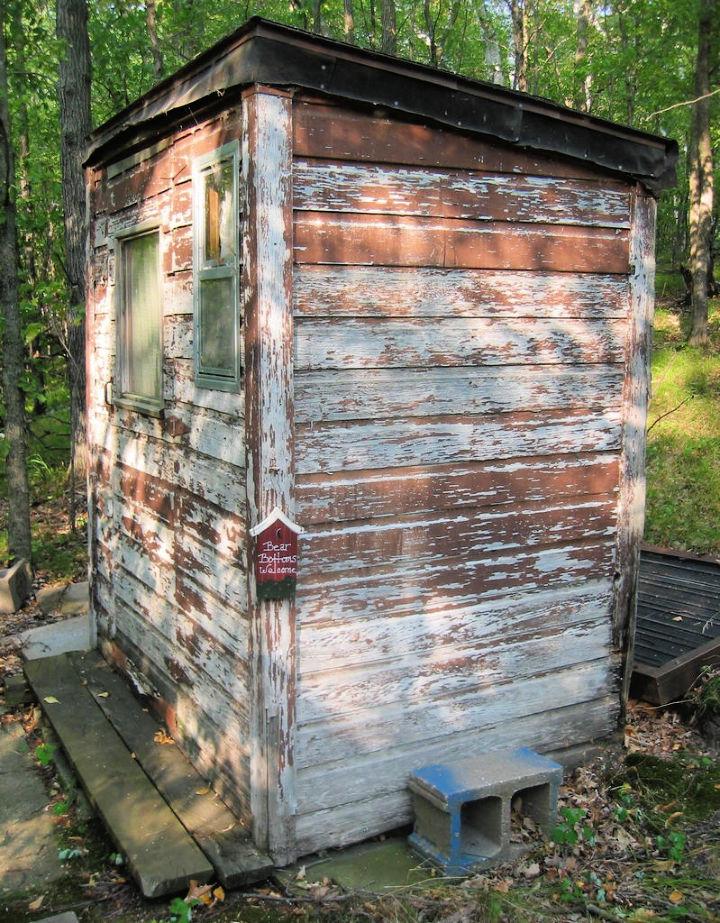
Transform your outdoor experience with Instructables‘ guide to creating the World’s Nicest Outhouse. Nestled in the serene Minnesota woods, this isn’t your average outhouse; it’s a testament to comfort and design. Step-by-step, learn how to build an outhouse that impresses with its thoughtful features and stylish touches. Ideal for cabin owners or outdoor enthusiasts, this tutorial ensures your next nature call is answered with a blend of practicality and charm. Embrace the DIY spirit and enhance your rustic retreat with an amenity that combines simplicity with a touch of luxury.
9. Sawdust Compost Outhouse
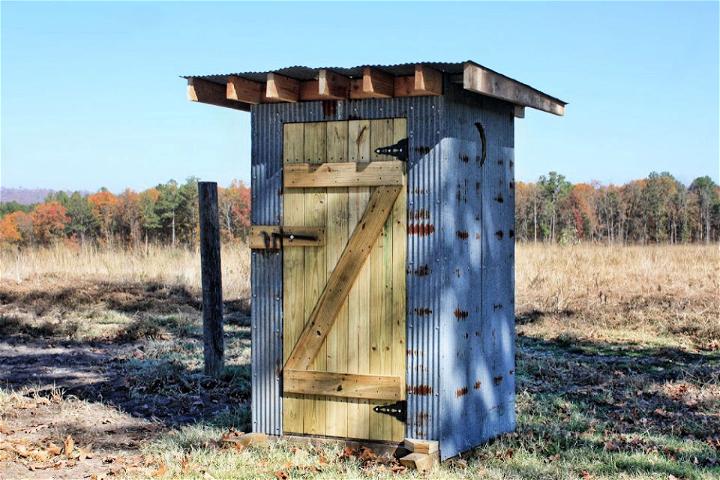
Planning to build an eco-friendly outhouse on your farm or ranch? Sport and Trail Magazine offers an insightful guide on creating a sawdust compost outhouse that’s both odor-free and environmentally conscious. Learn how to start with a layering system using sawdust, manage your compost pile effectively, and ensure your outhouse remains insect-free.
The article provides practical advice on design features to complement a rustic theme and includes tips for maintaining hygiene with biodegradable products. Whether for personal use or accommodating guests at events, this instructive piece will help you construct a movable, sustainable solution for your outdoor sanitation needs.
10. Make Your Own Outhouse
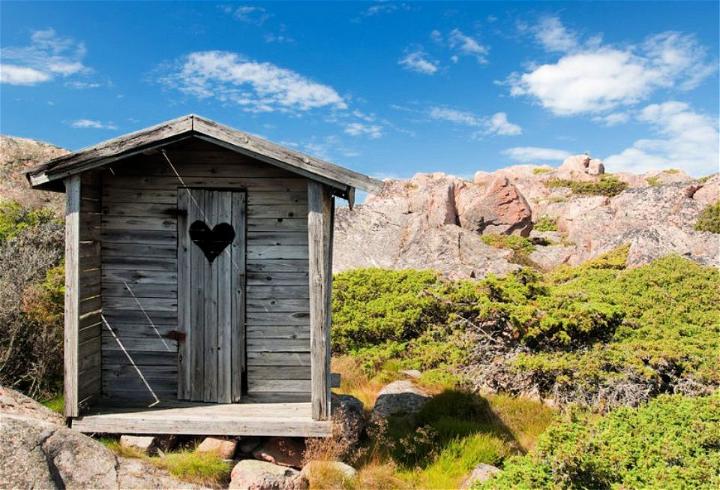
Building an outhouse is an essential skill for off-grid living, and Survival Mastery provides an instructive guide to make one that’s not only functional but also stylish. Before embarking on this DIY project, it’s crucial to verify local regulations to ensure compliance. The guide covers all necessary steps, from laying a sturdy foundation and constructing a robust frame to adding a seat and ensuring proper ventilation.
Regular maintenance tips and the potential to turn waste into compost for gardening are also discussed. With a focus on practicality and aesthetics, this comprehensive tutorial helps you build an outhouse that suits your needs while blending with the natural surroundings.
11. Modern DIY Outhouse On a Budget
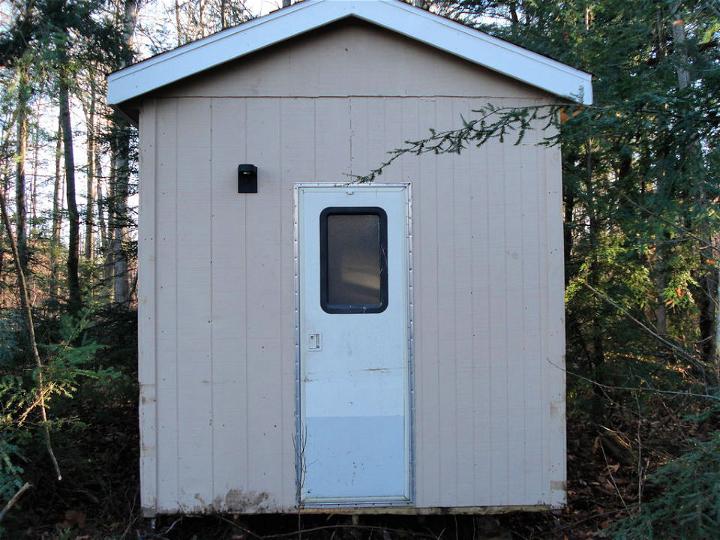
Building a modern outhouse on a budget can be a rewarding DIY project that adds convenience to your property. Instructables provides a comprehensive guide on constructing an 8×8 outhouse by repurposing materials from a dismantled camper, including the toilet, vanity, sink, shower, and windows.
With clear instructions and practical tips, this resource helps you create a functional and cost-effective outdoor bathroom. Ideal for those seeking to enhance their outdoor space, the tutorial ensures you can achieve a sturdy and aesthetically pleasing structure without breaking the bank. Get started on this eco-friendly project today and enjoy the benefits of your handiwork.
12. How to Make an Outhouse Using Pallet Wood
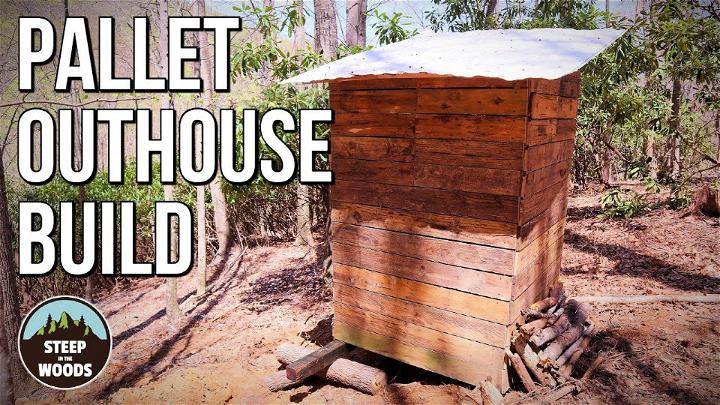
Embark on a rustic DIY journey with our guide on ‘Building an Outhouse out of pallet wood.’ Ideal for nature enthusiasts and outdoor adventurers, this project is not just practical but also an enriching experience. You’ll navigate through selecting durable materials like roofing panels, 4x4s, logs, and screws, ensuring a sturdy structure. The guide emphasizes the efficient utilization of resources, showcasing how to use natural elements for leveling and stability.
Learn to strategically position the outhouse for ease of access and environmental considerations. The building process is broken down into clear, manageable steps, making it accessible for DIYers of all levels. Experience the satisfaction of constructing a functional, eco-friendly outhouse, enhancing your outdoor living space with this unique, cost-effective solution.
13. How to Build an Outhouse Off the Grid
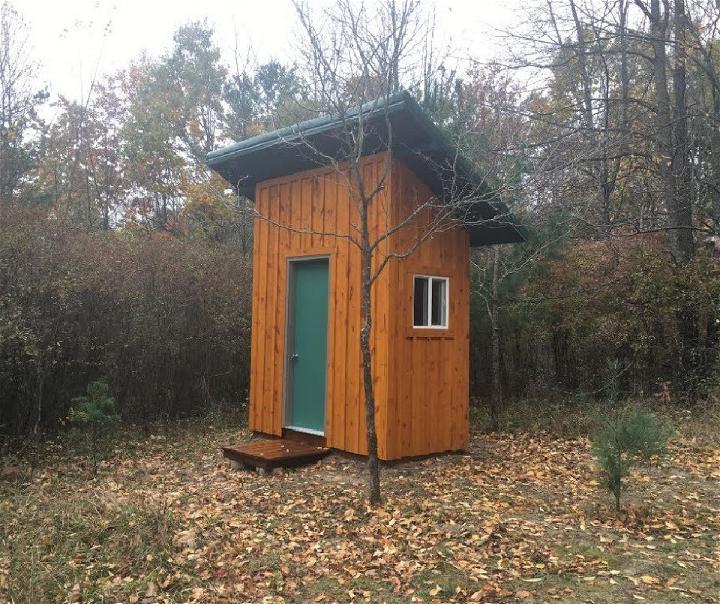
Find the path to a sustainable journey as we guide you through the construction of an eco-friendly, off-grid outhouse. Powered by two 100w 12v solar panels, this outhouse not only offers essential amenities but also champions green living. These solar panels, integral to the off-grid cabin, now extend their functionality to the outhouse, providing efficient lighting and ventilation.
Discover how to harness solar energy for your outdoor facilities, making them more than just functional but also a testament to renewable energy use. Ideal for eco-enthusiasts and outdoor adventurers, this guide illuminates the path to a self-sufficient lifestyle, seamlessly blending modern comforts with environmental consciousness.
14. DIY Outhouse at Home
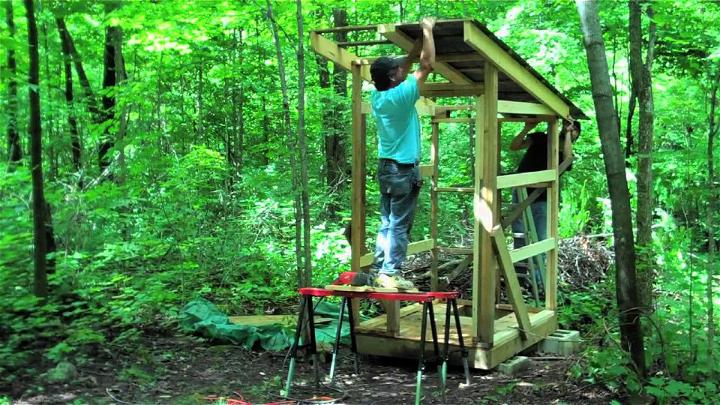
Experience a delightful DIY journey as you construct your very own outhouse, an enchanting and functional addition to any outdoor area. This guide, inspired by a detailed YouTube tutorial, walks you through the creation process, starting from digging a four-foot hole to installing a funky door and sophisticated flooring.
Materials needed include standard building supplies, and you’ll appreciate the emphasis on sturdy support beams for longevity. The design cleverly incorporates features like critter-proof grading and ventilation, ensuring comfort and functionality. The final touch? A choice between green or yellow paint for a personalized, vibrant finish. Perfect for those seeking a hands-on project that combines utility with a touch of whimsy.
15. Unique Outhouse Design
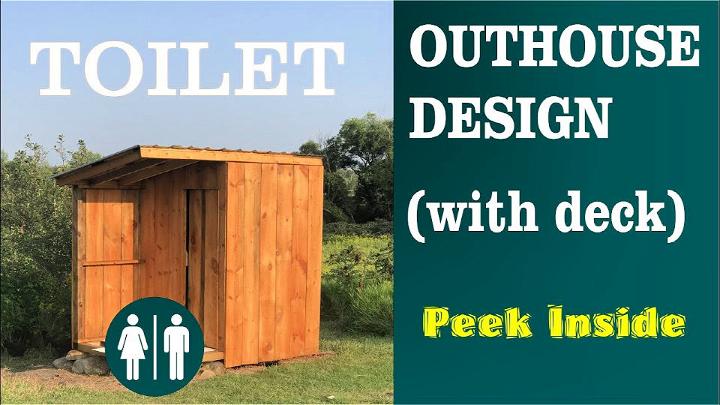
Undertake a practical and innovative journey with our DIY Outhouse Design, featuring a toilet and sink. This guide will walk you through creating a sturdy, functional outhouse with a simple yet effective design. Starting with essential materials like 3×4 beams and repurposed wood, you’ll learn how to construct a durable foundation with a rock footing.
The highlight is its eco-friendly aspect, including a rainwater storage tank and a running water sink on the deck. Ideal for outdoor spaces, this outhouse design promises an efficient, cost-effective solution for your sanitation needs, complying with local codes. Dive into this project to enhance your backyard with a blend of practicality and environmental consciousness.
Conclusion
In wrapping up our guide on 15 Free DIY Outhouse Plans, it’s clear that such projects can significantly enhance your outdoor space both functionally and aesthetically. With these carefully curated plans, anyone looking to construct an outhouse will find valuable resources and step-by-step guidance to make their project a success.
Our DIY outhouse plans, including blueprints, have covered a range of designs to suit diverse needs and preferences. We hope this collection inspires you to start your own DIY outhouse project and start on your path to a more sustainable living environment.
